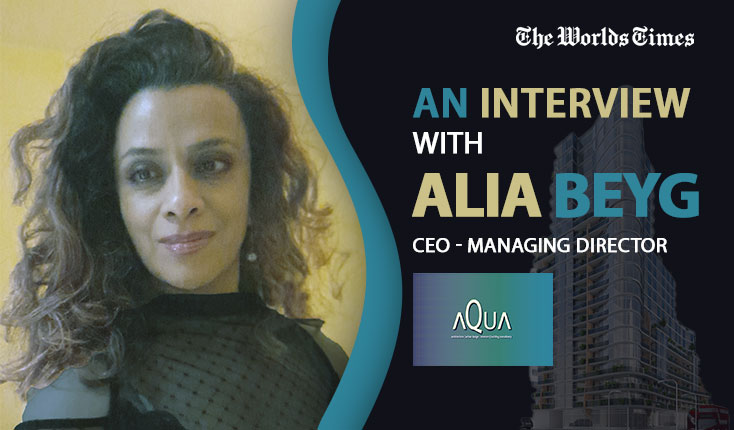Alia Beyg, an accomplished chartered architect, shares her journey from her education to the establishment of AQUA Architecture, a boutique studio known for its innovative approach to design. Starting with her innate passion for creativity and design, Alia’s career trajectory was shaped by her belief in blending artistry with architectural impact. Throughout her career, she has emphasized efficient and sustainable design, balancing aesthetic appeal with environmental considerations. Alia’s commitment to innovation is evident in her work, where she pushes the boundaries of architectural design using cutting-edge technologies and mindful strategies. Her dedication extends to addressing social and environmental challenges, as seen in her involvement in low-cost housing projects and volunteer work in underserved communities. Alia’s insights offer inspiration for aspiring architects, emphasizing the importance of clear intention, dedication, and a focus on adding value to make a positive impact in the field of architecture.
Unveiling Architectural Inspiration
We started the interview by asking, “What initially drew you to a career in architecture, and how did your education influence your approach to design?”
Alia Beyg replied, “Architecture chooses me, from the early days. Creativity was always my forte, and designing in various forms felt like second nature to me. It was clear to me from the start that I was meant to be a designer. Being educated from Bartlett, UCL felt like a validation of my true calling. However I went on to do a Masters in Artificial Intelligence in Architecture, which also evolved my path.
I always believed that art would be at the core of my work, and architecture provided the perfect avenue to blend creativity with a relevant impact on people’s lives and the built environment. It was, and continues to be, an aspirational journey for me. Designing spaces that not only function efficiently but also enhance the quality of life for those who inhabit them has been a deeply fulfilling journey for me. With every project, I strive to push the boundaries of design, constantly seeking innovative solutions that positively impact both individuals and communities alike.”
Charting the Course
The UK Times: Launching AQUA Architecture was a significant milestone in your career. Can you share the challenges you faced while establishing your own practice and how you overcame them?
Alia Beyg replied, “After conceptualizing the vision for Aqua Architecture, a boutique studio focused on innovation, the practice experienced rapid growth. Establishing a chartered RIBA accredited practice, defining best practices across sectors, and showcasing high-quality capabilities became early milestones. Witnessing this swift progress was indeed fortunate, but it was the assembly of an exceptional team and the acquisition of landmark projects that truly propelled us forward.
Founding my own brand and defining unique styles was immensely gratifying, devoid of the compromises often associated with larger corporate practices. However, the most significant milestones, as always, were securing exceptional projects that allowed us to demonstrate our expertise and make a tangible impact in the field of architecture.”
Harmonizing Beauty and Sustainability
The UK Times: You’ve emphasized efficient and sustainable design throughout your career. How do you balance aesthetic appeal with environmental considerations in your projects?
Alia Beyg replied, “The creative process of passive and environmental design is intricately intertwined with aesthetic appeal in our projects. From the outset, we meticulously incorporate low-tech strategies such as sunlight and daylight impact, materiality, and more to not only enhance the facade designs and openings but also to optimize building functionality.
For us, adopting an environmental approach isn’t merely an option; it’s an opportunity to craft something truly unique. Our meticulous attention to detail results in finely-tuned facades that seamlessly integrate with solar impact and energy efficiency considerations. In fact, our facade designs often take inspiration directly from the surrounding environmental conditions, ensuring a harmonious blend between form and function.
We establish strategies around these core principles right from the project’s inception. As an adjunct professor at Heriot-Watt University, I’ve had the privilege of lecturing on integrated technologies and climate change design to architecture students. This experience has not only been enlightening but has also contributed to refining our own strategies, aligning them with the net-zero plans outlined in the RIBA 2023 agenda. It’s been a rewarding journey, helping to shape the next generation of architects while further honing our commitment to sustainable design practices.”
Navigating Challenges
The UK Times: Working on marquee development projects across the globe must have offered unique challenges and learning. Can you discuss a project that was particularly challenging and how you navigated those challenges?
Alia Beyg replied, “I’ve had the privilege of being involved in a diverse array of schemes, each with its own momentum and potential for innovative thinking and solutions. Every project presents a unique set of challenges and opportunities. The architectural process is inherently multi-faceted, requiring us as lead consultants to consider numerous aspects throughout the design journey.
In our residential projects, our primary goal is to maximize the net area to add value for our clients. This often involves navigating through the complexities imposed by site limitations and local authorities, particularly in our high-rise endeavours like Premier Tower in Woking. Additionally, some of our projects are situated in conversation areas and involve listed buildings, such as Dorset House, Orchard House, and Warren House hotel.
Securing approval and meeting the requirements of local authorities is just one aspect of the process. The construction delivery of high-quality new schemes within the confines of stringent regulations poses another significant challenge. However, I’m proud to say that the Aqua team has excelled in both areas, navigating design interventions, coordinating efforts, and meticulously attending to technical detailing to ensure successful project outcomes.”
Cultivating Architectural Ingenuity
The UK Times: Innovation is at the core of AQUA Architecture’s ethos. Can you give an example of a project where you pushed the boundaries of architectural innovation?
Alia Beyg replied, “Innovation lies at the heart of our approach, characterized by our continual exploration of new ideas and progressive systems, all guided by forward-looking perspectives on design. Within my team, we’ve developed strategies that seamlessly integrate with the design process, such as our ‘Mindfulness and Wellness strategies’ and the Aqua ‘Eco strategies’. These frameworks not only inform our design decisions but also ensure that our projects prioritize the well-being of occupants and the sustainability of the environment.
To further enhance our creative capabilities, we’ve embraced cutting-edge technologies such as parametric software and AI imaging. These tools empower us to push the boundaries of the conceptual design process, allowing for unparalleled levels of precision and innovation. By leveraging parametric design principles, we’re able to generate complex forms and structures that would be impossible to achieve through traditional methods alone. Similarly, AI imaging enables us to analyse vast amounts of data and extract valuable insights, providing us with a deeper understanding of design challenges and opportunities.
This integration of technology into our workflow not only streamlines the design process but also opens up new possibilities for collaboration and experimentation. By embracing these tools, we’re able to continually reflect and rethink the way in which we design and work; ultimately enabling us to deliver high-end best practice solutions that exceed our clients’ expectations.”
Building Communities
The UK Times: Your interest in social and low-cost housing is commendable. What are some of the key strategies you employ to make these projects sustainable and socially impactful?
Alia Beyg replied, “The journey of Alia & Aqua Architecture has been marked by a commitment to innovation and adaptability, particularly in navigating the challenges presented by both pre and post-pandemic urbanization trends. Together with the dedicated Aqua team, I’ve had the privilege to develop and refine three critical strategies that underpin our approach to architecture.
First and foremost is our Eco strategy, which serves as the cornerstone of our commitment to sustainability. In an era where environmental concerns are increasingly prominent, we recognize the importance of designing with minimal ecological footprint. Our eco-conscious approach involves not only incorporating renewable materials and energy-efficient technologies but also considering the broader environmental context in which our projects are situated.
The second strategy, our Mindfulness in Architecture approach, underscores our belief in designing spaces that prioritize the well-being and mental health of occupants. We understand that the built environment has a profound impact on human psychology and behaviour, and as such, we strive to create environments that foster mindfulness, tranquillity, and connectivity with nature.
Lastly, our Micro Housing strategy reflects our dedication to addressing the pressing issue of affordable housing in urban areas. We recognize that low-cost housing solutions must not only be economically viable but also tailored to the specific needs and cultural context of the communities they serve. By adopting a humanistic approach and focusing on the fundamental need for shelter, we aim to create micro-housing solutions that are both efficient and dignified.
At the heart of our strategies lies a fundamental question: How can we add value? This question serves as our guiding principle, inspiring us to continually reflect on ways to enhance the quality and efficiency of our designs while remaining mindful of the broader social, environmental, and economic implications. By adhering to this principle, we are able to create architecture that not only meets the needs of today but also contributes positively to the world we inhabit tomorrow.”
Redefining Urban Living
The UK Times: The exploration of co-living and micro-apartment concepts is fascinating. How do you see these concepts evolving, and what role do they play in addressing housing crises?
Alia Beyg replied, “The global housing crisis has prompted designers and developers to revaluate their approach to designing homes, communities, and urban spaces, with a heightened focus on the health and well-being of residents. At Aqua Architecture, our response to this challenge has been the development of innovative micro-units and co-living concepts. These concepts prioritize communal facilities, ensuring that residents have access to high-quality units complemented by thoughtfully designed internal and external social spaces that foster community engagement and interaction. Our ideas have been successfully implemented in recent co-living and student accommodation schemes, demonstrating their effectiveness in addressing the evolving needs of modern living environments. By integrating our ideas into these developments, we’ve been able to create environments that not only provide comfortable and functional living spaces but also cultivate a sense of belonging and camaraderie among residents.
As we continue to grapple with the complexities of the housing crisis, our commitment remains steadfast: to design homes and communities that not only addresses the immediate need for shelter but also nurture the holistic well-being of their inhabitants.”
Global Impact
The UK Times: Your volunteer work in Africa and Asia is inspiring. How has this experience influenced your professional work and your approach to?
Alia Beyg replied, “We’ve dedicated our expertise to volunteer work on charitable projects, offering pro-bono architectural services in underserved communities, such as girls’ school and orphanage in Kenya, and refurbishing a school in Madagascar, Flood proof homes in Asia. Our goal is to design self-sufficient schemes that would empower people.
Simultaneously, the proliferation of AI technologies presents both immense opportunities and challenges. From enhancing building automation systems to optimizing energy management and resource allocation, AI has the potential to revolutionize the way we design, construct, and inhabit our built environment. However, we are just at the start of this journey which will evolve in its complexity and implications on the design process, and well as construction delivery.
Through education and training as well and providing shelter. Despite facing challenges along the way, including delays in obtaining approvals from local authorities and navigating funding constraints, we remained steadfast in our commitment.”
Overcoming Hurdles
The UK Times: What are some of the biggest challenges you face when incorporating sustainable design principles into your projects, and how do you address them
Alia Beyg replied, “At Aqua Architecture, we adhere to the overarching strategies, as mentioned, that encompass the entirety of a project’s lifecycle, from conception to completion. Central to these strategies is a holistic consideration of the full carbon footprint, as well as the integration of passive and active environmental strategies.
Our approach recognizes that each project is unique, with its own set of challenges and opportunities. Factors such as scale, sector, and geographical relevance play a crucial role in shaping our strategies. For instance, a large-scale commercial development in an urban setting may require different environmental considerations compared to a smaller residential project in a rural area.
Furthermore, we actively engage with stakeholders to ensure that our strategies are tailored to meet the specific needs and objectives of each project. This collaborative approach allows us to strike a balance between environmental responsibility and practical feasibility, ultimately delivering solutions that are both sustainable and economically viable.
By incorporating these overarching strategies into our projects, we strive to not only minimize environmental impact but also create spaces that enhance the well-being of occupants and contribute positively to the communities they serve.”
Charting the Course
The UK Times: Looking towards the future, what trends or innovations in architecture are you most excited about, and how is AQUA Architecture preparing to embrace these changes?
Alia Beyg replied, “In our era, few challenges loom larger or hold greater urgency than those posed by the climate emergency and the rapid advancement of artificial intelligence (AI). At Aqua Architecture, we recognize that these issues demand bold and proactive solutions, and we are committed to staying ahead of the curve by embracing them head-on within our design concepts in a provocative manner.
The climate emergency presents an existential threat that requires immediate and decisive action. We understand that the built environment plays a significant role in contributing to greenhouse gas emissions and environmental degradation. Therefore, we approach each project with a keen awareness of its environmental impact and strive to integrate sustainable design principles that minimize carbon footprint, promote energy efficiency, and harness renewable resources.
Simultaneously, the proliferation of AI technologies presents both immense opportunities and challenges. From enhancing building automation systems to optimizing energy management and resource allocation, AI has the potential to revolutionize the way we design, construct, and inhabit our built environment. However, we are just at the start of this journey which will evolve in its complexity and implications on the design process, and well as construction delivery.”
Guiding Principles for Architectural Activism
Lastly we asked, “What advice would you offer to aspiring architects who wish to make a positive impact through their work, both environmentally and socially?”
“Manifesting a clear intention goes a long way. As you embark on your journey to follow your dreams, remember to set clear targets, focus on adding and maximizing value, and above all, have dedication and determination to improve lives.” Alia Beyg concluded
Connect Alia Beyg on LinkedIn
Visit AQUA Architecture to learn more about it
Also Read:
Building Businesses and Transforming organisations through ethical data monetization
Distinguished Leader in BCI and Neurotechnology: Driven by Innovation and Impact
Elevating Grooming Standards Worldwide: STARMAXX CEO’s Inspirational Journey and Industry Insight


















